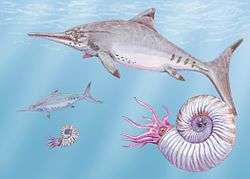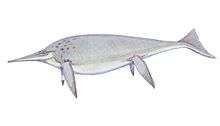Nannopterygius
Nannopterygius (meaning "small wing/flipper" in Greek) is a genus of ophthalmosaurid ichthyosaur that lived in the Middle Jurassic to the Early Cretaceous (Callovian to Berriasian stages).[1] [2] Fossils have been found in Europe, where there was a shallow and warm sea covering much of Europe at this time.[3] It therefore lived in shallow seas, probably around coral reefs, rather than in the open ocean. The first specimen was found in the Kimmeridgian Kimmeridge Clay Formation of Kimmeridge Bay, Dorset, UK and described by Hulke in 1871, who named it Ichthyosaurus enthekiodon.[4] This referred to its teeth being 'sheathed' in cementum and less likely to fall out than those of other ichthyosaurs.[5] A year earlier, Hulke had described some remains from the same horizon and locality that he thought were ichthyosaurian, naming them Enthekiodon (no species given).[6] These are now lost, but Hulke considered them sufficiently similar to demote the name to species level.[4] In 1922, Huene separated this species into the new genus Nannopterygius, named for the small fore- and hindpaddles.[7] The first fossil is the most complete, but is flattened. All subsequent fossils are fragmentary. In 2020, several more species, including N. borealis, and the species once contained in the genera Paraophthalmosaurus and Yasykovia were named based on remains found in Norway and Russia.[8]
| Nannopterygius | |
|---|---|
| Holotype of N. enthekiodon, displayed at the Natural History Museum, London | |
| Scientific classification | |
| Kingdom: | Animalia |
| Phylum: | Chordata |
| Class: | Reptilia |
| Order: | †Ichthyosauria |
| Family: | †Ophthalmosauridae |
| Genus: | †Nannopterygius von Huene, 1922 |
| Type species | |
| †Nannopterygius enthekiodon (Hulke, 1871) | |
| Species | |
| |
| Synonyms | |
| |
Features

Nannopterygius was small for an ichthyosaur, at only 2.5 metres (8.2 ft) long. About 1 metre (3.3 ft) of this was tail, including a deeply forked and probably homocercal caudal fin. The head is 50 centimetres (20 in; 1.6 ft) long, with a typical long narrow rostrum. The eyes are large, hence its classification as an ophthalmosaurid, and have a bony sclerotic ring inside the eye socket. There are at least 60 disc-shaped vertebrae, although owing to the condition of the fossil it is not possible to tell exactly how many there were, showing that Nannopterygius was flexible, agile and probably a fast swimmer. The ribs are long and curved, but do not quite join up. Most of the features are very similar to the close relative Ophthalmosaurus. However, its paddles are much smaller, around 25–30 centimetres (9.8–11.8 in) for the forepaddles and only 10–15 centimetres (3.9–5.9 in) for the hindpaddles.[5] This gave it a very streamlined, torpedo-shaped look, but would have made it quite difficult to generate much lift or to turn quickly, making it an inefficient long-distance swimmer but speedy over short distances. It is therefore possible that it was an ambush predator which plunged into shoals of fish quickly in the shallow seas where it lived.
See also
- List of ichthyosaurs
- Timeline of ichthyosaur research
References
- McGowan, C. & Motani, R. 2003. Ichthyopterygia. In Sues, H.-D. Handbook of Paleoherpetology, vol. 8. Verlag Dr. Friedrich Pfeil, Munich, 175 pp., 19pls.
- Nikolay G. Zverkov; Megan L. Jacobs (2020). "Revision of Nannopterygius (Ichthyosauria: Ophthalmosauridae): reappraisal of the 'inaccessible' holotype resolves a taxonomic tangle and reveals an obscure ophthalmosaurid lineage with a wide distribution". Zoological Journal of the Linnean Society. Online edition. doi:10.1093/zoolinnean/zlaa028.
- Maisch MW, Matzke AT. 2000. The Ichthyosauria. Stuttgarter Beiträge zur Naturkunde Serie B (Geologie und Paläontologie) 298: 1-159
- Hulke, J. W. Note on an Ichthyosaurus (I. enthekiodon) from Kimmeridge Bay, Dorset. Quarterly Journal of the Geological Society, 27, 440–441, pl. 17.
- "Nannopterygius enthekiodon - Palaeocritti - a guide to prehistoric animals". sites.google.com. Retrieved 2018-06-10.
- Hulke, J. W. Note on some teeth associated with two fragments of a jaw from Kimmeridge Bay. Quarterly Journal of the Geological Society, 26, 172–174.
- Huene, F. F. von 1922. Die Ichthyosaurier des Lias und ihre Zusammenhänge. Verlag von Gebrüder Borntraeger, Berlin, 114 pp., 22 pls.
- Nikolay G. Zverkov; Megan L. Jacobs (2020). "Revision of Nannopterygius (Ichthyosauria: Ophthalmosauridae): reappraisal of the 'inaccessible' holotype resolves a taxonomic tangle and reveals an obscure ophthalmosaurid lineage with a wide distribution". Zoological Journal of the Linnean Society. Online edition. doi:10.1093/zoolinnean/zlaa028.

